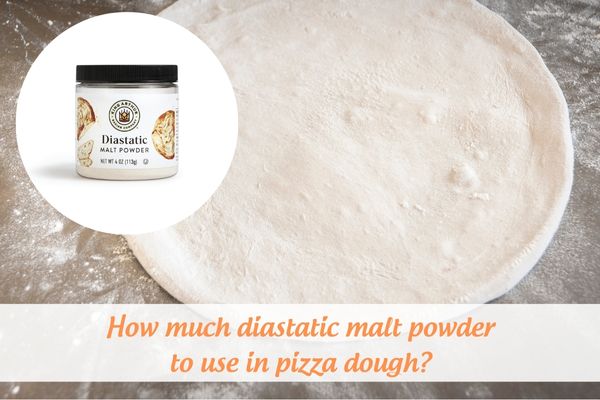Crafting the perfect pizza dough is an art form that has captivated culinary enthusiasts and home cooks alike. One of the lesser-known but critical ingredients in achieving that coveted texture and flavor in pizza dough is diastatic malt powder. This comprehensive guide will explore the nuances of how much diastatic malt powder to use in pizza dough, ensuring your crust is nothing short of perfection.
Read more Articles at: https://beststandmixerforpizzadough.com/
What is diastatic malt powder?
Before delving into the specifics of how much diastatic malt powder should be incorporated into pizza dough, it is essential to understand what this ingredient is and why it holds significance in baking. Diastatic malt powder is derived from barley grains that have been sprouted, dried, and ground. This process unlocks a treasure trove of enzymes, most notably amylase, which plays a pivotal role in breaking down starches into sugars. These sugars are then available for yeast consumption, which is crucial for fermentation, leading to dough rise and enhanced flavor.
The inclusion of diastatic malt powder in baking, especially in pizza dough, has been a practice revered by seasoned bakers for its ability to improve texture and color. The enzymatic activity attributed to the malt powder not only aids in the leavening process but also contributes to the Maillard reaction. This chemical reaction is responsible for the golden-brown crust that is highly sought after in pizzas.
Understanding the foundation of what diastatic malt powder is and its functionality sets the stage for exploring its optimal use in pizza dough recipes. This knowledge is instrumental in appreciating the precision required in using this ingredient to elevate the quality of homemade pizza.
The role of diastatic malt powder in pizza dough
Integrating diastatic malt powder into pizza dough recipes is not merely a matter of tradition but a science-backed practice that enhances the dough’s properties. The enzymes present in the malt powder stimulate the breakdown of starches in the flour into simpler sugars. These sugars serve a dual purpose: they feed the yeast during fermentation, promoting a robust rise, and contribute to the caramelization of the crust during baking.
The significance of diastatic malt powder in pizza dough can be observed in the texture and flavor of the final product. Doughs that incorporate this ingredient tend to exhibit a superior rise, resulting in a light, airy crust. Additionally, the enhanced browning and caramelization effect impart a depth of flavor and a visually appealing golden hue to the crust, distinguishing it from doughs devoid of malt powder.
Moreover, the use of diastatic malt powder in pizza dough recipes can be a game-changer in managing the dough’s fermentation process. By providing a consistent source of food for the yeast, the fermentation process becomes more predictable, allowing for greater control over the dough’s development. This level of precision is crucial for bakers aiming to achieve consistent results in their pizza-making endeavors.
Understanding the importance of using the right amount of diastatic malt powder
The benefits of incorporating diastatic malt powder into pizza dough are manifold. However, these advantages can only be fully realized when the correct quantity of malt powder is used. Utilizing an excessive amount can lead to adverse effects, such as an overly rapid fermentation process, resulting in a dough that is difficult to handle and may overproof. Conversely, insufficient quantities may not provide enough enzymatic activity to make a noticeable impact on the dough’s rise and flavor.
The balance in using diastatic malt powder lies in its ability to harmonize with the other ingredients in the dough recipe. It acts as a catalyst, enhancing the natural processes that occur during fermentation without overpowering them. This delicate equilibrium is key to achieving a dough that boasts an optimal rise, texture, and flavor profile.
Acknowledging the critical nature of the correct usage of diastatic malt powder underscores the necessity of precise measurement and understanding of its role in dough development. It is this comprehension that empowers home cooks and professional bakers alike to harness the full potential of diastatic malt powder in crafting exceptional pizza dough.
Factors to consider when determining the amount of diastatic malt powder
Identifying the ideal quantity of diastatic malt powder for pizza dough necessitates a consideration of several factors. These include the type of flour used, the desired fermentation time, and personal taste preferences. Each of these elements plays a pivotal role in calibrating the amount of malt powder to be used.
The protein content of the flour is a critical determinant in the amount of diastatic malt powder required. High-protein flours, such as bread flour, have a greater capacity to absorb water and develop gluten, necessitating a different approach to malt powder addition compared to all-purpose flour. Similarly, the fermentation time significantly influences the quantity of malt powder needed. Longer fermentation periods may benefit from reduced amounts of malt powder to prevent over-fermentation, while shorter times may require a slight increase to boost enzymatic activity.
Personal taste preferences also guide the decision-making process in determining the right amount of diastatic malt powder. Some individuals may prefer a more pronounced malt flavor and a darker crust, warranting a higher quantity of malt powder. In contrast, others may favor a subtler influence, necessitating a more conservative approach.
These factors underscore the importance of tailoring the quantity of diastatic malt powder to the specific circumstances of each pizza dough recipe. It is this customization that ensures the desired outcomes in texture, flavor, and appearance are achieved.
Calculating the ideal quantity of diastatic malt powder for your pizza dough recipe
Arriving at the perfect quantity of diastatic malt powder for pizza dough involves a blend of scientific understanding and personal experimentation. A general guideline is to start with a ratio of 0.5% to 1% of the flour’s weight. For instance, if the recipe calls for 1000 grams of flour, adding between 5 to 10 grams of diastatic malt powder would be within the recommended range.
Adjusting within this range based on the factors previously discussed—such as flour type, fermentation time, and taste preferences—allows for fine-tuning the dough’s characteristics. It is advisable to make incremental adjustments and document the outcomes, facilitating a systematic approach to identifying the optimal quantity of malt powder.
Moreover, engaging in trial and error is an invaluable part of the process. Crafting several batches of dough with varying amounts of diastatic malt powder offers practical insights into its impact on the dough’s behavior and the final pizza’s quality. This hands-on experience is instrumental in mastering the art of using diastatic malt powder in pizza dough recipes.
Common mistakes to avoid when using diastatic malt powder
Navigating the use of diastatic malt powder in pizza dough can be fraught with potential pitfalls that may hinder achieving the desired results. One common mistake is the overuse of malt powder, which can lead to an excessively rapid fermentation process and an overly browned crust. This misstep underscores the importance of adhering to the recommended ratios and making adjustments based on observation and experience.
Another error is neglecting to consider the type of flour and its protein content when determining the amount of malt powder to use. This oversight can result in suboptimal dough performance, as the malt powder’s enzymatic activity may not be properly balanced with the flour’s characteristics.
Additionally, failing to account for the ambient temperature and its impact on fermentation can lead to inconsistent results. Higher temperatures can accelerate fermentation, potentially necessitating adjustments in the quantity of diastatic malt powder to maintain control over the dough’s development.
Awareness of these common mistakes and adopting a meticulous approach to using diastatic malt powder can significantly enhance the quality of pizza dough, ensuring it meets the baker’s standards in texture, flavor, and appearance.
Tips and tricks for achieving the perfect texture and flavor with diastatic malt powder
To harness the full potential of diastatic malt powder in pizza dough, several tips and tricks can be employed. Firstly, incorporating the malt powder into the dough at the beginning of the mixing process ensures its even distribution and optimal interaction with the flour. This practice facilitates a uniform fermentation process, contributing to a consistent texture throughout the dough.
Secondly, pairing diastatic malt powder with a controlled fermentation process—such as cold fermentation—can amplify its benefits. The slower fermentation rate allows for a gradual development of flavors and textures, enhancing the overall quality of the pizza crust.
Lastly, experimenting with different brands and types of diastatic malt powder can offer unique nuances in flavor and performance. Each product may vary in its enzymatic activity and malt flavor intensity, providing opportunities to customize the dough according to personal preferences and desired outcomes.
Adopting these strategies can elevate the pizza-making experience, enabling bakers to create doughs that boast the perfect balance of texture, flavor, and appearance, thanks to the judicious use of diastatic malt powder.
Diastatic malt powder alternatives for pizza dough
In situations where diastatic malt powder is unavailable or a different flavor profile is desired, several alternatives can be considered. Honey and malt syrup are viable options, offering similar enzymatic properties that can aid in the fermentation process. These substitutes also impart a distinct sweetness and color to the dough, adding another dimension to the flavor profile.
Non-diastatic malt powder, while lacking in enzymatic activity, can contribute to the dough’s color and flavor, serving as a cosmetic alternative. However, its inability to facilitate starch breakdown into sugars means it cannot fully replicate the functional benefits of diastatic malt powder in pizza dough.
Exploring these alternatives provides flexibility in pizza dough preparation, allowing bakers to adapt to available ingredients while still striving for high-quality results. It is this adaptability that underscores the creative aspect of pizza making, encouraging experimentation and personalization in the quest for the perfect pizza dough.
Expert recommendations and advice on using diastatic malt powder in pizza dough
Seeking insights from seasoned bakers and culinary experts can further refine the use of diastatic malt powder in pizza dough recipes. One common piece of advice is to view diastatic malt powder as a tool for fine-tuning dough characteristics rather than a mandatory ingredient. Its use should be driven by the specific goals for the dough, whether that’s enhancing fermentation, improving browning, or adjusting flavor.
Experts also emphasize the importance of quality ingredients and precise measurements. The quality of the diastatic malt powder, along with the flour and other components of the dough, significantly impacts the final product. Accurate measurement ensures consistency and repeatability, essential factors in mastering pizza dough preparation.
Furthermore, continuous learning and adaptation are encouraged. The journey to perfect pizza dough is ongoing, with each batch providing opportunities to refine techniques and experiment with different ratios of diastatic malt powder. Embracing this process with curiosity and an open mind can lead to remarkable improvements and a deeper understanding of the art of pizza making.
Conclusion: Mastering the art of using diastatic malt powder in your pizza dough
The journey to mastering the use of diastatic malt powder in pizza dough is both a science and an art. It requires an understanding of the ingredient’s properties and functions, as well as a willingness to experiment and learn from each baking experience. By considering the factors that influence the amount of diastatic malt powder, avoiding common mistakes, and applying tips and tricks from experts, bakers can enhance the texture, flavor, and appearance of their pizza dough.
Adapting to the nuances of diastatic malt powder usage and exploring alternatives when necessary further enriches the pizza-making experience. The guidance and insights provided in this guide aim to empower bakers to confidently integrate diastatic malt powder into their recipes, elevating their pizza dough to new heights of perfection.
The art of using diastatic malt powder in pizza dough is a testament to the creativity and precision that defines the culinary world. It is a journey that rewards patience, experimentation, and a deep appreciation for the ingredients that contribute to the magic of a perfectly crafted pizza.

